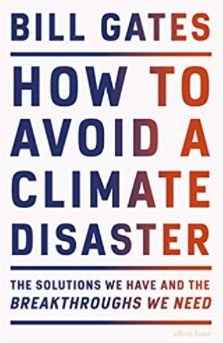
How to avoid a climate disaster
How to Avoid a Climate Disaster presents a convincing explanation of how the world can stop global warming by reducing greenhouse gas emissions effectively to zero, thereby avoiding a climate disaster. Gates argues that a combination of furious innovation, the adoption of best practices, smart investment, and clearly defined government policies can steer our economies and steadily decarbonise our world. I would like to briefly highlight below some of the observations and suggestions Gates provides in this book.
To avoid a climate disaster we need to reach net zero by 2050. Why net zero? The world adds ~51 billion tons of greenhouse gases to the atmosphere every year. Greenhouse gases trap heat, causing the average surface temperature of the earth to go up. The more gases there are, the more the temperature rises, and once greenhouse gases are in the atmosphere, they stay there for a very long time; something like one-fifth of the carbon dioxide emitted today will still be there in 10,000 years. Therefore, we need to aim for near net zero to stop warming and avoid the negative impacts of weather change. In climate terms, a change of just a few degrees is a big deal. During the last ice age, the average temperature was just six degrees Celsius lower than today. During the age of the dinosaurs, the temperature was four degrees Celsius higher than today. Even though the global mean has gone up just one degree Celsius since preindustrial times, some areas around the world have already started experiencing temperature increases of more than two degrees Celsius. These regions are home to between 20-40% of the world’s population.
Gates focuses on five major emissions-generating activities and their contribution; 31% of emissions are caused by making things (cement, steel, plastic), 27% by plugging things in (electricity), 19% from growing things (plants, animals), 16% from getting around (planes, trucks, cargo ships), and 7% from keeping warm and cool (heating, cooling, refrigeration). Interestingly, electricity, 27% of the problem, could represent much more than 27% of the solution. With clean electricity, we could shift from burning hydrocarbons for fuel and, whilst on its own it won’t get us to zero, it will be a key step.
Accomplishing near-net zero emissions is a gigantic uphill task, one which has never been done before, and needs to be done much faster than any similar precedent. Take oil – the world uses more than four billion gallons every day. A key challenge here will be building a climate consensus globally. Considering how fundamental fossil fuels are in our lives, there is simply no way we will stop using them widely within a decade. What we can do is to adopt the policies in the next 10 years that will put us on a path to achieving net zero by 2050. Renewable sources of energy, solar and wind, can play a substantial role in getting us to zero and we should be deploying renewables quickly wherever it is economical to do so. However, they cannot offer a full solution as intermittency (they don’t generate electricity 24 hours a day) and deficits of wind and sun in certain areas of the world remain key obstacles. That leads us to why the world is going to need some new clean inventions too.
Gates proposes a two part solution which must be used in unison to achieve net zero. First, we must expand the supply of innovations. Research and development is required to make nuclear energy safer, produce green hydrogen, develop grid scale electricity storage that can last a full season, create advanced biofuels, manufacture zero carbon cement and steel, pioneer plant and cell based meat and dairy, advance zero carbon fertilizer and so on. To do this, governments need to quintuple clean energy and climate related R&D budgets over the next decade, and make bigger bets on high-risk high-reward R&D projects.
The second part of the solution involves accelerating the demand for innovations to give inventors and policy makers the incentive to push out new ideas, scaling them and making them cheaper (reducing the green premium) through supportive government policies and large-scale procurement. Introducing a carbon tax would also help to lower the green premium, making it easier for middle and low income countries to adopt these technologies and reduce their emissions.
We all can contribute as citizens, using voice and vote to demand plans for climate change from elected officials. As a consumer, we can reduce our carbon emissions and send a signal to the market that people want zero carbon alternatives and are willing to pay for them. When you pay more for an electric car, a heat pump, or a plant based burger, you are saying “There’s a market for this stuff, we’ll buy it.” As an employer, set up an internal carbon tax, prioritise innovation in low carbon solutions, be an early technology adopter, engage in the policy-making process, connect with government funded research, and help early-stage innovators get across the valley of death.
We are at the same point today with climate change as we were several years ago with pandemics. Despite the health experts’ warnings, the world did not do enough to prepare. We should not make the same mistake with climate change.
Shahil Shah
June 2021
